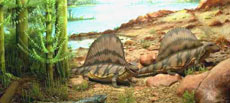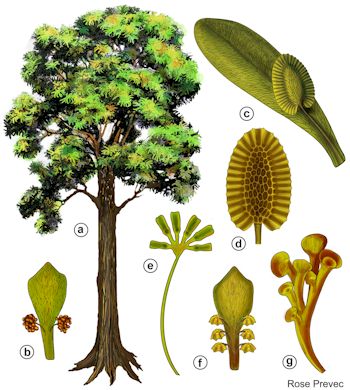 |
 |
 |
 |
 |
Produced
by the Population Genetics and Evolution class, Furman University |
||||
 |
 |
 |
 |
 |
Produced
by the Population Genetics and Evolution class, Furman University |
||||
 |
Glossopteris |
 |
||
| Glossopteris
was a genus of woody gymnosperms that was common through out the continent
of Gondwana, providing another piece of evidence for the theory of continental
drift (Fossil Museum 2010). They were found in wet, swampy habitats, much
like bald cypress (Fossil Museum 2010). It is speculated that Glossopteris
was deciduous and resembled some of the conifers alive today; however,
instead of needles they had large broad lance-shaped leaves that ranged
from 2 to 100 cm in length (Wikipedia 2010). These leaves had a distinctive
mid rib and reticulate venation (Encyclopedia Britannica 2010). Since
very few specimens show these leaves attached to the branches, and there
are a wide variety of venation patterns, classifying Glossopteris
into species is difficult; as well as determining what a Glossopteris
tree actually looked like (Fossil Museum 2010)! Glossopteris
became one of the dominant plants during the Permian by producing seeds
(Speer 1997). Pollen and ovule bearing structures were found on different
leaves (Encyclopedia Britannica 2010). Seeds were produced on the underside
of a leaf or in hanging clusters on other leaves, much like the ferns
(Speer 1997). As such, this genus belongs to primitive group of gymnosperms
sometimes called the "seed ferns". Page by Chapin Hardy |
 |
| Reconstruction of Glossopteris. Photo Credit: Science in Africa. | |
| Encyclopedia Britannica. 2010. Glossopteris. Accessed March 15, 2010. Fossil Museum. 2010. Detailed Permian Glossopteris Leaf. Accessed March 15, 2010 Spear BR. 1997. University of California Museum Paleontology (UCMP). Introduction to the Glossopteridales. Accessed March 15. 2010. Wikipedia. 2010. Glossopteris. Accessed March 15, 2010. |